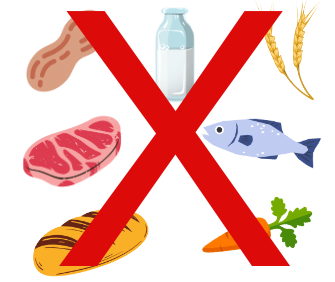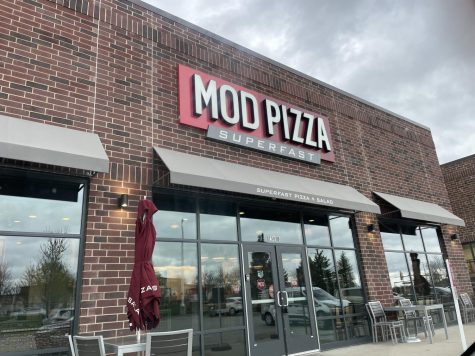Food allergies make going out to eat a nightmare
April 18, 2023

Millions of people suffer from allergies and intolerances that make it difficult to eat out.
Imagine going out to eat at the world’s finest restaurant. The lights are dimmed, the smell of garlic and spices fills the air. The sizzle of cooking food is audible through the kitchen doors.
Now imagine not being able to eat a single thing. It sucks, right? Well, for many people with allergies and intolerances, this nightmare is a reality as many restaurants fail to accommodate people with conditions such as tree nut allergies or gluten intolerances.
For junior Lorelei Hengst, not being able to eat out is the hardest thing about having allergies. Since she was ten years old, Hengst has had to avoid tree nuts, gluten, dairy, oats, soy and corn due to her severe allergies and intolerances. It’s difficult for her to find restaurants to accommodate her many sensitivities.
“Whenever I want to go out with friends, they will want to go to Noodles and Company, but I don’t think there’s a single thing I can eat there. Or McDonald’s, I have to get just fries or stuff like that. So it’s definitely hard to eat out,” Hengst said.
One restaurant Hengst can eat out at is Culver’s, though. She goes there every Sunday with her friends due to their efforts to accommodate her. Sophomore Payton DiProspero, who works at Culver’s, takes part in making sure people’s food is safe for them to consume.

“Culver’s addresses food restrictions by accommodating guests with certain conditions. So, if you have a gluten allergy, we have gluten-free buns to provide. Culver’s provides a veggie burger for vegetarians, and if you for example have a nut allergy, we also run fresh custard and get different scoops and ladles to avoid cross-contamination,” DiProspero said.
Cross-contamination is one of the biggest issues facing people with allergies when they eat out. It occurs when one food item comes in contact with another food item and therefore becomes tainted. For example, a gluten-free bun touching a wheat bun – the gluten-free bun would be contaminated with gluten and would not be safe for someone with severe gluten sensitivities or celiac disease.
This is the reason that many restaurants claim to have “allergy-friendly” foods: it’s difficult to say that something is absolutely “allergy-free” because of cross-contamination between the many different food items and utensils being moved around a restaurant’s kitchen. It is vital that restaurants make sure to clean off equipment and carefully handle allergy-friendly foods, like Culver’s does.
“Usually when there’s cross-contamination, I’ll be able to feel it right away. I’ll eat something, and I’ll be like, ‘oh this was near something that I can’t have or something I can’t have is in it,’ but usually it’s such a small trace that it’s ok,” junior Patricia Suchanek, who has several different allergies, said.
Suchanek especially can’t eat raw fruits and vegetables, which makes it difficult for her to eat healthy.
“Having those restrictions is difficult because they’re very contradictory. Like you would say, ‘eating healthy is eating fruits and vegetables,’ but I can’t have those, so it’s just finding a balance and actually trying to eat healthy and not eating junk all the time,” Suchanek said.
Something that makes it a lot easier for Suchanek to eat out is being able to customize her food and choose to remove things that she’s allergic to. Places that don’t pre-make their food are best, Suchanek says.
MOD Pizza is one of these easily-customizable restaurants, with a make-your-own pizza option. Junior Riley Whitlock, who works at MOD Pizza, explains the different build-your own options. 
“MOD Pizza has two different crust options for people who are sensitive or allergic to gluten; we have the gluten-free crust and then a cauliflower crust, and they also have a dairy-free cheese. We have vegan meats too,” Whitlock said.
These options are not without a cost, though. While Culver’s only charges an extra $1.20 for a gluten-free bun, MOD charges an extra $3 for their gluten-free crust and $3.20 for their cauliflower option. Not only is allergy-friendly food hard to find, but it’s more expensive, too.
People truly can’t help what they are allergic to, so it is important for restaurants to not only make sure their customers can safely eat there, but also avoid overcharging them for something they can’t control.
To truly accommodate people with food restrictions, restaurants could lower the extra cost, make their food items more customizable (although most restaurants allow this) and make sure there is no cross-contamination with allergy-friendly food.
DiProspero appreciates that there are still restaurants like Culver’s who are easily customizable and are careful about cross-contamination.
“I think it’s important to provide alternatives so that people who have food restrictions still feel as though they can eat the same foods as other people can and eat in the same restaurants,” DiProspero said.